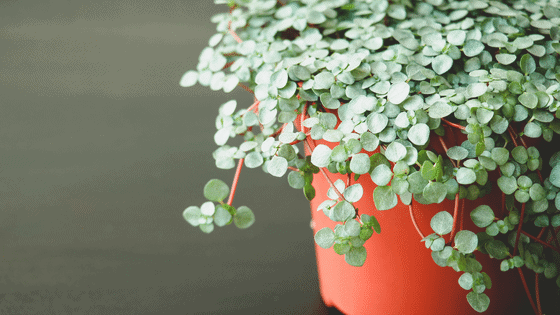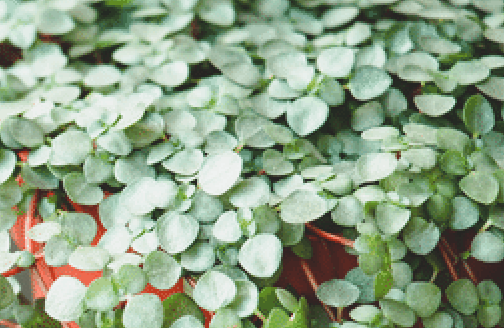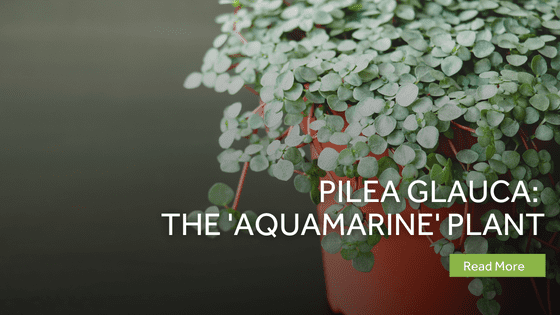Are you looking for a stunning vining plant that is easy to care for? The Pilea glauca, sometimes referred to as the Pilea libanensis or Pilea glycophylla, has delicate grey leaves and reddish stems that are bound to impress. Read on to become an expert in Pilea glauca care!
Table of Contents
Pilea Glauca Overview
Pilea glauca does not yet have a confirmed scientific name but is sometimes called the Pilea libanensis, Pilea glycophylla, aquamarine plant, red stem pilea, silver sparkle Pilea, or grey artillery plant. No matter what name you use, rest assured this terrestrial vining plant with round leaves will look stunning in your home.
Native to south and central America, this species is one of many tropical plants that enjoy a warm, humid environment with plenty of bright indirect light. The Pilea glauca belongs to the Urticaceae family, the Nettle family, and the genus Pilea.
Other distinguished Pilea types include the Chinese Money Plant, Aluminum Plant, and the Friendship Plant.
Pilea varieties include:
Chinese Money Plant: the Pilea peperomioides is a plant with shiny circle leaves that resemble coins.
Aluminum Plant: Long, oval-shaped leaves adorned with silvery patches earned the Pilea cadierei its namesake.
Friendship Plant: The Pilea involucrata species is striking with its highly textured oval leaves of green and burgundy.
| Botanical Name | Pilea glauca |
| Family | Urticaceae |
| Genus | Pilea |
| Origin | South and Central America |
| Sunlight | Bright indirect sunlight |
| Watering | Moderate |
| Soil | Well-draining and aerated |
| Temperature | 65-80 degrees Fahrenheit |
| Propagating Pilea | Stem cuttings |
| Re-Potting | When rootbound |
| Pests and Diseases | Common houseplant pests and root rot |
| Toxicity | Non-toxic to humans and pets |

The Silver Plant Features
The glauca plant is a beautiful evergreen perennial species that is fast-growing. The plant can grow up to 12 inches in height, with leaves about four inches wide. It is often called the gray artillery plant or silver Pilea plant due to its silvery green leaves.
This species does produce tiny flowers in shades of white, pink, and peach closer to the stems of the plant in clusters. The Pilea glauca does not produce fruit and is non-toxic to humans and pets, making this an ideal houseplant.
The Pilea Plant Care Guide
Baby Tears plant care is a breeze with these tips and tricks, even more so with Pilea glauca being a fairly low-maintenance plant. This species prefers a warm environment with lots of humidity.
Moist soil and fertilizer in the growing season are great additions to keeping this plant happy. Additionally, finding the right space with not too much direct sunlight is important for Pilea glauca care.
Ideal Growing Place
Pilea glauca can be grown indoors or outdoors with the proper temperature, humidity, soil, and lighting conditions. The grey baby tears plant is a popular houseplant for many since it looks stunning growing in a hanging basket. This species even makes for a good terrarium plant. Its climbing and vining nature give your space a green sparkle!
The growing season for Pilea glauca is the spring and summer months, when we see considerable growth and beautiful blooms popping up along the stems. The colder fall and winter months bring a slower growth rate and reduced water and fertilizer requirements.
Water
Watering your Pilea glauca can take time to adjust as you learn the plant’s patterns. This species prefers the soil moist but not soggy to avoid excess moisture settling in around the roots. The best way to determine if it is time to water is by checking the top two inches of soil. If you place two fingers in the upper soil layers and it feels dry, give your plant a nice watering.
Sunlight
Another important aspect of Pilea glauca care is providing the right lighting for your plant. Avoid placing your plant directly in the path of sunlight as this can scorch the tiny silvery grey leaves. The best lighting for your grey baby tears plant is bright indirect sunlight.
Place your Pilea glauca near a brightly lit window to give it some rays, and be mindful of rotating your plant so each side can get sunlight. A common sign that your plant needs additional lighting is if your plant becomes leggy. A boost from artificial light is okay as this species does well with that.
Temperature
The Pilea glauca care guide suggests the plant be kept in temperatures of 65-80 degrees Fahrenheit. Tropical plants like this enjoy a warm environment similar to their native habitat. If you want to plant your Pilea glauca outdoors, be mindful of your climate and temperature ranges. This temperature range is perfect for growing this species as a pretty indoor plant.
Soil
The Pilea glauca care recommendations for soil are on par for most tropical plants. This incredible plant prefers well-drained soil with plenty of aeration. Since the Pilea glauca prefers the soil to be consistently moist, you need soil that can retain some moisture but still drain well. Be sure to use a pot that has drainage holes to help with this.
This plant does well with organic soil amendments such as peat and perlite. These compounds help the soil retain moisture while allowing air pockets for the roots.
Humidity
The Pilea glauca is an adaptable plant to many humidity levels making it great to have indoors. Since it is native to tropical areas, it does best in a high humidity environment but can easily adjust to household humidity levels. You can use a humidifier or water pebble tray for your plant to provide extra humidity.
Fertilizer
Good Pilea glauca care includes providing your plant a liquid fertilizer at half strength once a month during the growing season. It is best to provide fertilizer once the soil is freshly watered during the spring and summer months. Once the fall and winter are here, you can cease fertilizing since the plant is not growing so rapidly.
Pinching/Pruning
Pruning your Pilea glauca is straightforward and includes disposing of dying or dead leaves and trimming if desired. If you are using your plant in a terrarium or as ground cover, it may be beneficial to prune your bushier plant to allow more airflow.
If you are looking to prune a bushy plant or simply take some length off the vines, gather your sterile tools like shears or a sharp knife and cut off your leaf stems at the main branch of the plant. If you want to reduce the volume of your plant drastically, do it in stages, so you do not send your plant into major shock.
Potting and Re-potting
If your Pilea glauca plant appears happy and healthy, it may only need to be repotted every 2-3 years or when it is seriously root-bound. This plant does not mind a little snugness in the roots and pot but will need more space over time. Repotting can cause stress to your plant, so it is best to do it during the spring growing season.
When selecting a new pot, make sure it has drainage holes, fresh potting mix, and is only one size up. These tips can make the repotting process easier for your plant.
Growth Zone
USDA Plant Hardiness Zones 10 and 11 are suitable for Pilea glauca care. If you want to use your Pilea glauca for outdoor ground cover, check the map to see if your area is in those zones. The major areas in zones 10 and 11 include the west coast and southern states, closer to their respective bodies of water.
Common Pests, Toxins, Diseases & Other Problems
Common household plant pests such as spider mites, mealy bugs, and aphids can affect your Pilea. These tiny insects can feed off your plant’s sap and even cause leaf mold. You can treat these pests with a spray of 1 cup of rubbing alcohol to one quart of water or gentle products like neem oil or insecticidal soaps.
Other issues can arise from too much moisture exposed to your plant. Southern blight, leaf spot, and Pilea root rot can result from overwatering or too high of humidity. When too much moisture is in the air, it can fall and rest on your plant’s leaves, leaving them more susceptible to mold and powdery mildew.
Pilea Glauca Propagation
The best Pilea propagation method is taking stem cuttings. Find a stem cutting about one to two inches long with a node, then remove a few leaves from the bottom. Next, cut your section off with sterilized shears or a sharp knife. Propagate Pilea in the spring for best results.
You can propagate this cutting by placing it in water or soil, but soil planting is better for stronger roots than water. Once you have the cutting, place it in good contact with soil without clamping soil down around it since it prefers aeration. Water your cutting well, and place a plastic wrap over the container to encourage high humidity. To avoid mold or mildew, ventilate your plastic wrap every few days.
Related Article: Pilea Depressa Baby Tears Plant: Important Tips and Tricks
Pilea Glauca Plant Mature Timeline
Now that you know how to propagate Pilea glauca, root growth will occur on the stem cutting in about one to two weeks. After the roots are a few inches long, you are ready to plant this in a new pot or terrarium and resume Pilea glauca care.

Pilea Glauca Care FAQ
Is Pilea Glauca Easy to Care For?
Pilea glauca care is very straightforward, making this plant perfect for both novices and plant experts.
Is Pilea Glauca a Succulent?
Yes, the Pilea glauca is considered an evergreen succulent vine.
How Big Does a Pilea Glauca Get?
Pilea glauca plants can grow about 12 inches tall and have mature leaves up to four inches wide.
Where to Buy Pilea Glauca Aquamarine Plant?
One well-known shop that carries the Aquamarine plant is Walmart. However, if you would like to order online, consider nursery shops that can ship directly to you or other sites like Etsy, where people can sell their propagated plants.
Is Pilea Glauca Rare?
This species of Pilea is considered rare and uncommon but is becoming more popular as a houseplant.
Is Pilea Glauca Toxic to Cats, Dogs, and Humans?
The Pilea aquamarine is non-toxic to humans and pets, but it is still a good idea to keep it out of the reach of children and animals.
Does Pilea Glauca Like to Be Root Bound?
The Pilea glauca likes to be a little root-bound and snug, but not too much. Once your roots run out of space in the current pot, it is time to repot up a size.
Why Are My Pilea Glauca Leaves Curling?
Curling leaves on your Pilea glauca can indicate that your watering, temperature, or lighting levels are off. Plant pests can also negatively affect your plant in this way.
Why Are My Pilea Glauca Leaves Turning Yellow?
Yellow leaves indicate that you have an overwatered Pilea and it’s likely not getting enough sunlight. Keep soil moist but not waterlogged, and provide bright indirect sunlight.
Why Are My Pilea Glauca Leaves Turning Brown?
If your leaves begin to turn brown, you may be giving your plant too much direct light. This strong light can scorch your leaves.
Why Is My Pilea Glauca Aquamarine Plant Dying?
If your plant shows signs of death, the most significant contributors are improper lighting, watering, and temperature. If you can rule those factors out, look to the humidity, soil, and fertilizing.
The Bottom Line
If you are looking for an easy-to-care-for but gorgeous vining plant, the Pilea glauca is a perfect option. Adding this plant to your space adds some green magic with its silver sparkle leaves, dainty Pilea flower, and reddish stems. Many people love its low-maintenance tendencies and enjoy using it in terrariums, hanging baskets, and as ground cover in a garden. Follow our expert care guide, and you will become an expert in all things Pilea glauca!
Last Updated on August 27, 2022 by Gustaf Johansson




